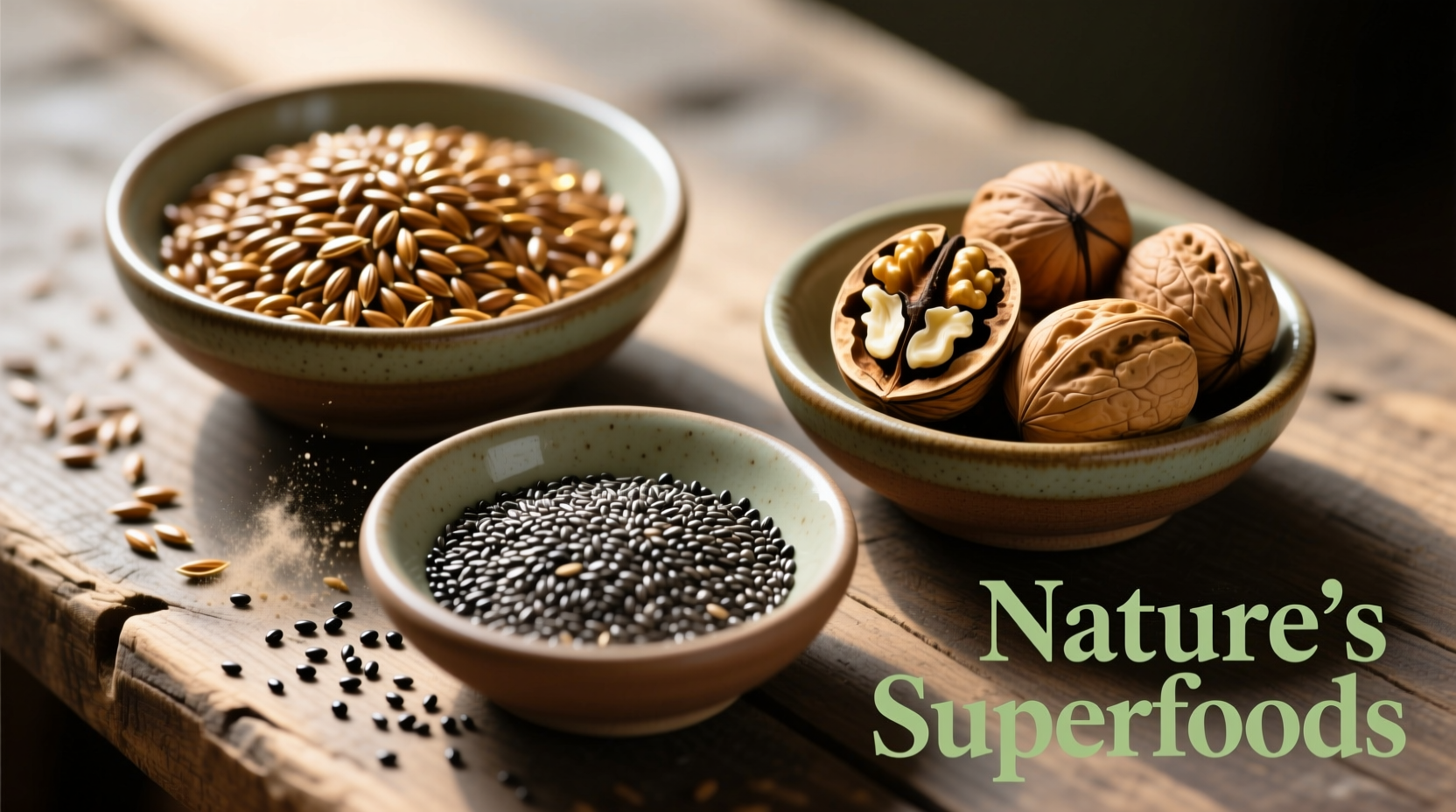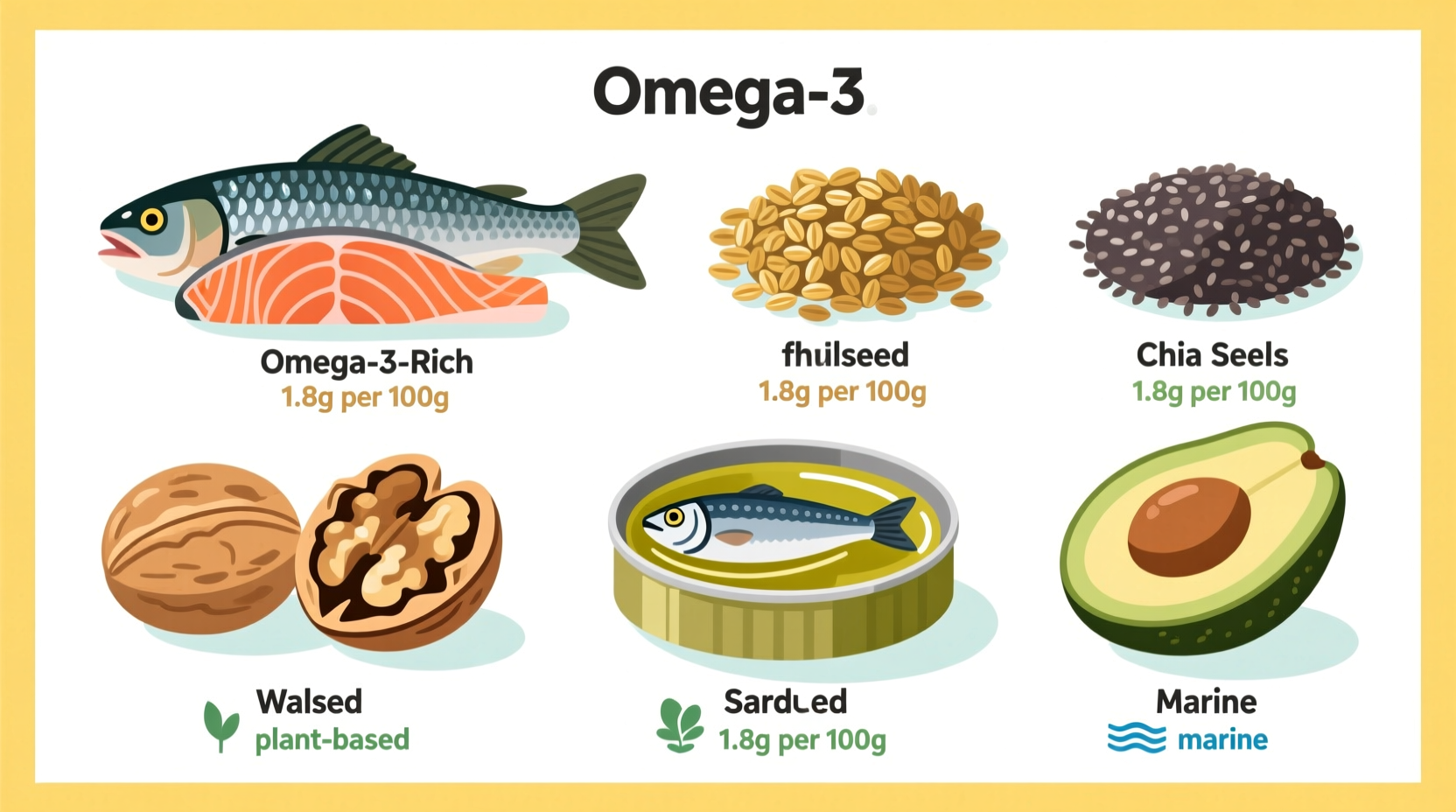Why Omega-3 Fatty Acids Matter for Your Health
Omega-3 fatty acids represent essential fats your body cannot produce on its own. The three primary types—ALA (alpha-linolenic acid), EPA (eicosapentaenoic acid), and DHA (docosahexaenoic acid)—play critical roles in cardiovascular health, brain function, and inflammation regulation. According to the National Institutes of Health, adults should consume 1.1-1.6 grams of ALA daily, with additional EPA and DHA recommendations varying by health status.
Your Complete Guide to Omega-3 Food Sources
Marine Powerhouses: Highest EPA and DHA Content
Fatty fish deliver the most bioavailable forms of EPA and DHA omega-3s—the types your body uses most efficiently. Unlike plant-based ALA, which requires conversion (and loses effectiveness in the process), marine sources provide direct access to these critical fatty acids.
| Food Source | Portion Size | EPA+DHA Content | Sustainability Rating |
|---|---|---|---|
| Salmon (wild-caught) | 3 oz cooked | 1,800 mg | ★★★★☆ |
| Mackerel (Atlantic) | 3 oz cooked | 1,000 mg | ★★★☆☆ |
| Sardines (canned) | 3.75 oz can | 1,400 mg | ★★★★★ |
| Herring | 3 oz cooked | 900 mg | ★★★☆☆ |
| Anchovies | 2 oz canned | 800 mg | ★★★★★ |
According to the FDA and EPA joint advisory, consuming 8-12 ounces of a variety of seafood weekly provides optimal omega-3 benefits while minimizing mercury exposure. Smaller fish like sardines and anchovies offer excellent omega-3 content with lower mercury levels compared to larger predatory fish.
Plant-Based Omega-3 Sources: Understanding ALA Conversion
For vegetarians, vegans, or those avoiding fish, plant sources provide ALA omega-3s that your body converts to EPA and DHA—though at relatively low efficiency (typically 5-10% conversion rate). This means you'll need to consume larger quantities to achieve similar benefits.

These plant-based options deliver substantial ALA content along with additional nutrients:
| Plant Source | Portion Size | ALA Content | Additional Benefits |
|---|---|---|---|
| Flaxseeds (ground) | 1 tbsp | 1,600 mg | High in fiber, lignans |
| Chia seeds | 1 oz (28g) | 5,000 mg | Complete protein, calcium |
| Walnuts | 1 oz (14 halves) | 2,500 mg | Antioxidants, magnesium |
| Hemp seeds | 3 tbsp | 3,000 mg | Complete protein, zinc |
| Algal oil supplements | 1 capsule | 200-300 mg DHA | Vegan DHA source |
Research published in the American Journal of Clinical Nutrition indicates that regular consumption of algal oil provides a reliable vegan source of DHA, bypassing the inefficient ALA conversion process. This makes it particularly valuable for pregnant women, children, and older adults who need direct DHA sources.
Fortified Foods and Practical Incorporation Strategies
Many everyday foods now come fortified with omega-3s, though amounts vary significantly. When choosing fortified options, check labels for actual EPA/DHA content rather than just "omega-3" claims, as some products only add ALA.
Smart ways to boost your omega-3 intake:
- Add 1 tablespoon of ground flaxseed to your morning smoothie or oatmeal (providing 1,600 mg ALA)
- Replace regular cooking oil with canola or soybean oil when sautéing vegetables
- Snack on a small handful of walnuts (about 14 halves) for 2,500 mg ALA
- Choose omega-3 enriched eggs (typically containing 150-200 mg per egg)
- Make chia pudding by soaking 3 tablespoons chia seeds in 1 cup almond milk overnight
Proper storage matters—omega-3 rich foods like flaxseeds and walnuts should be kept in airtight containers in the refrigerator or freezer to prevent oxidation and rancidity. When cooking with fish, baking or steaming preserves more omega-3s than high-heat frying methods.
When Food Sources Aren't Enough: Understanding Your Needs
Certain populations may require additional omega-3 support beyond food sources alone. The American Heart Association recommends fish oil supplements for individuals with coronary heart disease (1 gram EPA+DHA daily) and those with high triglycerides (2-4 grams under medical supervision).
Consider supplementation if you:
- Follow a strict plant-based diet without algal oil supplementation
- Have documented omega-3 deficiency
- Experience conditions benefiting from higher doses (inflammatory disorders, depression)
- Cannot consume adequate seafood due to allergies or dietary restrictions
Always consult with a healthcare provider before starting high-dose supplementation, as omega-3s can interact with blood-thinning medications and affect surgical outcomes.











 浙公网安备
33010002000092号
浙公网安备
33010002000092号 浙B2-20120091-4
浙B2-20120091-4